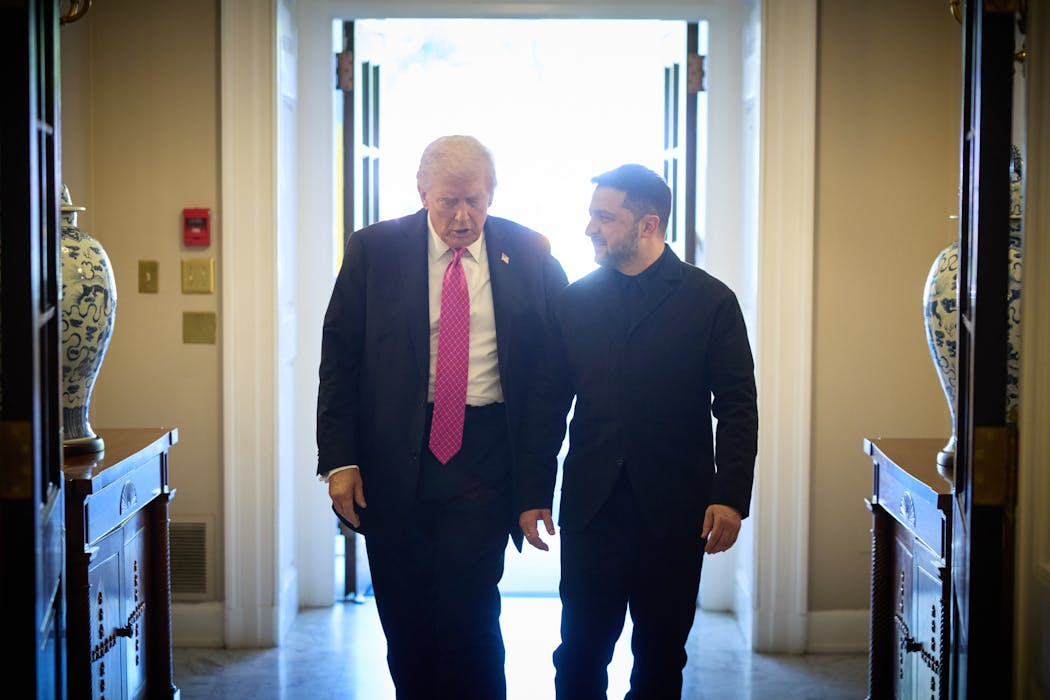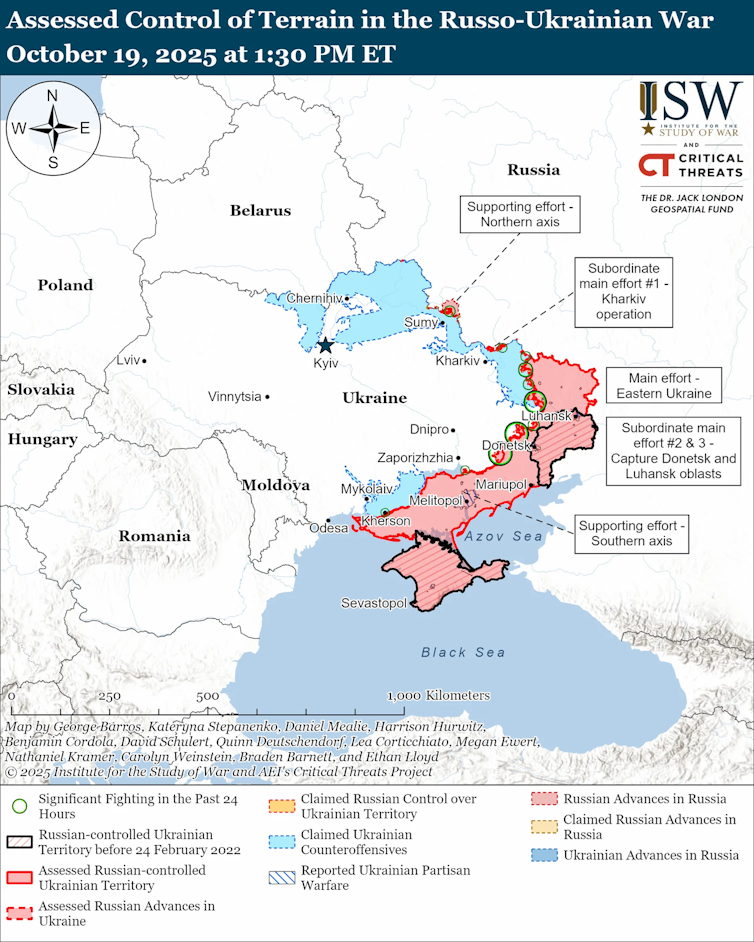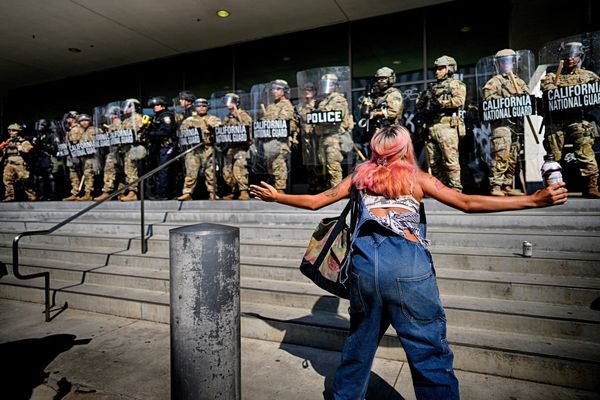
Within 24 hours last week Donald Trump performed yet another pivot in his approach to the Russian war against Ukraine. It’s become a familiar pattern of behaviour with the US president. First he expresses anger and frustration with his Russian counterpart, Vladimir Putin. Then he threatens severe consequences.
And finally – usually after some contact with the Russian president – he finds some imaginary silver lining that, in his considered view alone, justifies backing down and essentially dancing to the Russian dictator’s tune again.
The latest iteration of his by now very predictable sequence of events has unfolded as follows. Back in September, while he was still busy pushing his ultimately unsuccessful campaign to be awarded the Nobel peace prize, the US president began to envisage a Ukrainian victory against Russia. This, he said, would involve Kyiv reclaiming all territory lost to Russia’s aggression since the illegal annexation of Crimea in 2014.
To make this happen, there was suddenly talk of US deliveries of Tomahawk missiles to Ukraine. Access to these missiles would enable strikes against Russian military assets and energy infrastructure far beyond the current reach of most of Ukraine’s weapons. Trump and the Ukrainian president, Volodymyr Zelensky, spoke twice by telephone on October 11 and 12 to discuss the details. A deal was expected to be announced after they met in the White House on October 17.
Yet, the day before that meeting, Trump, apparently at the Kremlin’s request, took a phone call from Putin. Over the course of two hours of flattery and promises of reinvigorated trade relations, the Russian president managed to get Trump to back off his threat to supply Ukraine with Tomahawks.
This message was promptly delivered the following day to the Ukrainian delegation led by Zelensky. While clearly not as disastrous as their first encounter in the White House in February this year, Ukraine’s humiliation was clear.
Not only were Tomahawks taken off the table, but Kyiv and its European allies are essentially back to square one and the very real possibility of a deal between Putin and Trump. Or rather two deals to be hammered out by senior officials first and then sealed at another Trump-Putin summit in Budapest.
The first deal would likely be on the broader terms of a peace settlement. After the meeting, Trump posted on his social media channel that Russia and Ukraine should simply accept the current status quo and stop the fighting. With Trump thus appearing keen – again – to stop the fighting in Ukraine on the basis of a compromise between Russia and Ukraine means that Ukraine would lose as much as 20% of its internationally recognised territory. This is something that Kyiv and its European allies have repeatedly said is unacceptable.
The second deal would be on resetting relations between Washington and Moscow. This is something that Trump has been keen on for some time and suggests that more severe sanctions on Russia and its enablers, including India and China, are unlikely to be forthcoming any time soon.
Before Zelensky’s trip to Washington, there appeared to be some genuine hope that a ceasefire could be established as early as November. But Trump’s arrangements with Putin do not mention a ceasefire. Instead they make an end to the fighting conditional on a deal between the US and Russian presidents, which Zelensky is then simply expected to accept.
This will put further pressure on Ukraine, which suffers from daily attacks against critical infrastructure and is particularly harmful to the country’s economy and civilian population and foreshadows another difficult winter.
Russia continues its push for territory
So far, so bad for Ukraine. But this was not an accidental outcome that could have gone the other way, depending on the whims of Trump. Ever since the US president appeared to shift gear in his approach to the war in late September, the Kremlin carefully prepared the ground for a rapprochement between the two presidents – with a mixture of concern, threats and a good dose of flattery.
The goal of this rapprochement, however, is not a better peace deal for Russia. Putin surely knows this is unrealistic. Rather, it appears that the Kremlin’s main goal was buying itself more time to continue ground offensive in the Donbas.

This is best achieved by preventing the US from fully backing the position of Ukraine and its European allies. In this context, the choice of venue for a potentially deal-clinching summit between Trump and Putin is also interesting.
It will not be possible for Putin to travel to Budapest without flying through Nato airspace and through the airspace of countries that are at least candidate states for EU membership. This will put serious pressure on the EU and Nato to allow Putin passage or otherwise be seen as obstructing Trump’s peacemaking efforts – a narrative that the Kremlin has been peddling for some time, part of its strategy to disrupt the transatlantic relationship.
On the other hand, Trump’s latest turnaround – difficult as it may be for Kyiv to stomach – does not bring Ukraine closer to defeat. In Ukraine, mobilisation is in full swing and domestic arms production is increasing. Ukraine is further helped by the commitment of more than half of Nato’s member states to supply Kyiv with more US weapons.
There are three key takeaways from the diplomatic flurry over the past few weeks.
First, for all of Putin’s bluster, the threat of supplying Ukraine with Tomahawk missiles clearly had an effect. Putin made a move to reach out to Trump, thereby exposing an obvious vulnerability on Russia’s part. Second, and this barely needed confirmation, Trump is not a dependable ally of Ukraine or within the transatlantic alliance. He clearly has not given up on the possibility of a US-Russia deal, including one concluded behind the back and at the expense of Ukraine and European allies.
Finally, Zelensky may be down again after his latest fruitless encounter with Trump, but Ukraine is definitely not out. After all, Trump was right that Russia is a bit of a paper tiger and Ukraine can still win this war, or at least negotiate an acceptable settlement. Until Europe steps up, the key to this remains in the White House.
Stefan Wolff is a past recipient of grant funding from the Natural Environment Research Council of the UK, the United States Institute of Peace, the Economic and Social Research Council of the UK, the British Academy, the NATO Science for Peace Programme, the EU Framework Programmes 6 and 7 and Horizon 2020, as well as the EU's Jean Monnet Programme. He is a Trustee and Honorary Treasurer of the Political Studies Association of the UK and a Senior Research Fellow at the Foreign Policy Centre in London.
Tetyana Malyarenko does not work for, consult, own shares in or receive funding from any company or organisation that would benefit from this article, and has disclosed no relevant affiliations beyond their academic appointment.
This article was originally published on The Conversation. Read the original article.







